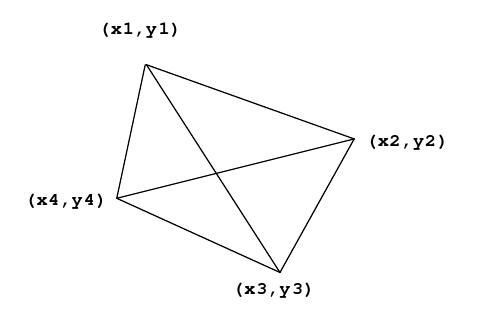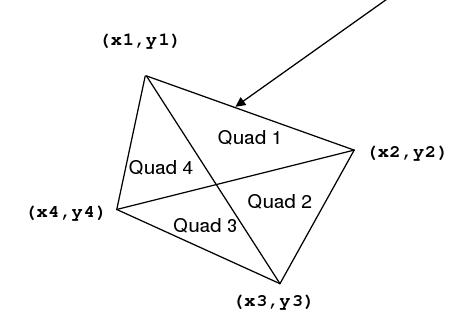标签:
主题链接:http://acm.hdu.edu.cn/showproblem.php?pid=3103


1 2 1 5 5 2 2 0 3.5 2.2 4.8 -9.6 -1.2 -4.4 -8.9 12.4 0.0 0.0 0.0 0.0 0.0 0.0 0.0 0.0
5.100 11.459 3.400 9.045 0.900 6.659 0.600 4.876 44.548 38.972 21.982 25.997 20.342 38.374 10.038 19.043
题意:
给出四个点,连接对角线后,分为四个象限。依照面积大小依次输出,假设面积同样则依照周长大小输出(注意:比較面积是否同样是比較保留了三位后是否同样);
代码例如以下:
#include<stdio.h>
#include<string.h>
#include<math.h>
#include<algorithm>
using namespace std;
const double eps = 1e-5;
const double PI = acos(-1.0);
struct point
{
double x, y;
};
struct gao
{
double mz,zc;
};
struct gao gg[10];
bool cmp(gao a,gao b)
{
if(a.mz!=b.mz)
return a.mz>b.mz;
return a.zc>b.zc;
}
double xmult(double x1,double y1,double x2,double y2,double x0,double y0)
{
return (x1-x0)*(y2-y0)-(x2-x0)*(y1-y0);
}
//判两点在线段同側,点在线段上返回0
int same_side(point p1,point p2,point l1,point l2)
{
return xmult(l1.x,l1.y,p1.x,p1.y,l2.x,l2.y)*xmult(l1.x,l1.y,p2.x,p2.y,l2.x,l2.y)>0;
}
//两点距离
double dis(point a,point b)
{
return sqrt((a.x-b.x)*(a.x-b.x)+(a.y-b.y)*(a.y-b.y));
}
//两线段的交点
point intersection(point u1,point u2,point v1,point v2)
{
point ret=u1;
double t=((u1.x-v1.x)*(v1.y-v2.y)-(u1.y-v1.y)*(v1.x-v2.x))
/((u1.x-u2.x)*(v1.y-v2.y)-(u1.y-u2.y)*(v1.x-v2.x));
ret.x+=(u2.x-u1.x)*t;
ret.y+=(u2.y-u1.y)*t;
return ret;
}
//三点面积
double aera(point a,point b,point c)
{
double aa,bb,cc,q;
aa=dis(c,b);
bb=dis(a,c);
cc=dis(b,a);
q=(aa+bb+cc)/2;
double h=sqrt(q*(q-aa)*(q-bb)*(q-cc));
h=(int)(h*1000+0.5);
return h*0.001;
}
//三点周长
double get_zc(point a,point b,point c)
{
double aa,bb,cc,q;
aa=dis(c,b);
bb=dis(a,c);
cc=dis(b,a);
q=(aa+bb+cc);
return q;
}
int main()
{
int i;
double x1,y1,x2,y2,x3,y3,x4,y4;
point a,b,c,d,e;
while(scanf("%lf%lf%lf%lf%lf%lf%lf%lf",&x1,&y1,&x2,&y2,&x3,&y3,&x4,&y4)!=EOF)
{
if(x1==0 && y1==0 && x2==0 && y2==0 && x3==0 && y3==0 && x4==0 && y4==0)
break;
a.x=x1;
a.y=y1;
b.x=x2;
b.y=y2;
c.x=x3;
c.y=y3;
d.x=x4;
d.y=y4;
if(same_side(a, b, c,d)==0)
e = intersection(d,c,a,b);
else if(same_side(d, b, c, a)==0)
e = intersection(d,b,c,a);
else
e = intersection(b,c,d,a);
gg[0].mz=aera(a,b,e);
gg[1].mz=aera(b,c,e);
gg[2].mz=aera(c,d,e);
gg[3].mz=aera(a,d,e);
gg[0].zc=get_zc(a,b,e);
gg[1].zc=get_zc(b,c,e);
gg[2].zc=get_zc(c,d,e);
gg[3].zc=get_zc(a,d,e);
sort(gg,gg+4,cmp);
for(i=0; i<3; i++)
printf("%.3lf %.3lf ",gg[i].mz,gg[i].zc);
printf("%.3lf %.3lf\n",gg[i].mz,gg[i].zc);
}
return 0;
}
/*
2 0 2 2 0 2 0 0
*/
版权声明:本文博主原创文章,博客,未经同意不得转载。
HDU 3103 Shoring Up the Levees(计算几何 搜寻区域)
标签:
原文地址:http://www.cnblogs.com/lcchuguo/p/4811564.html